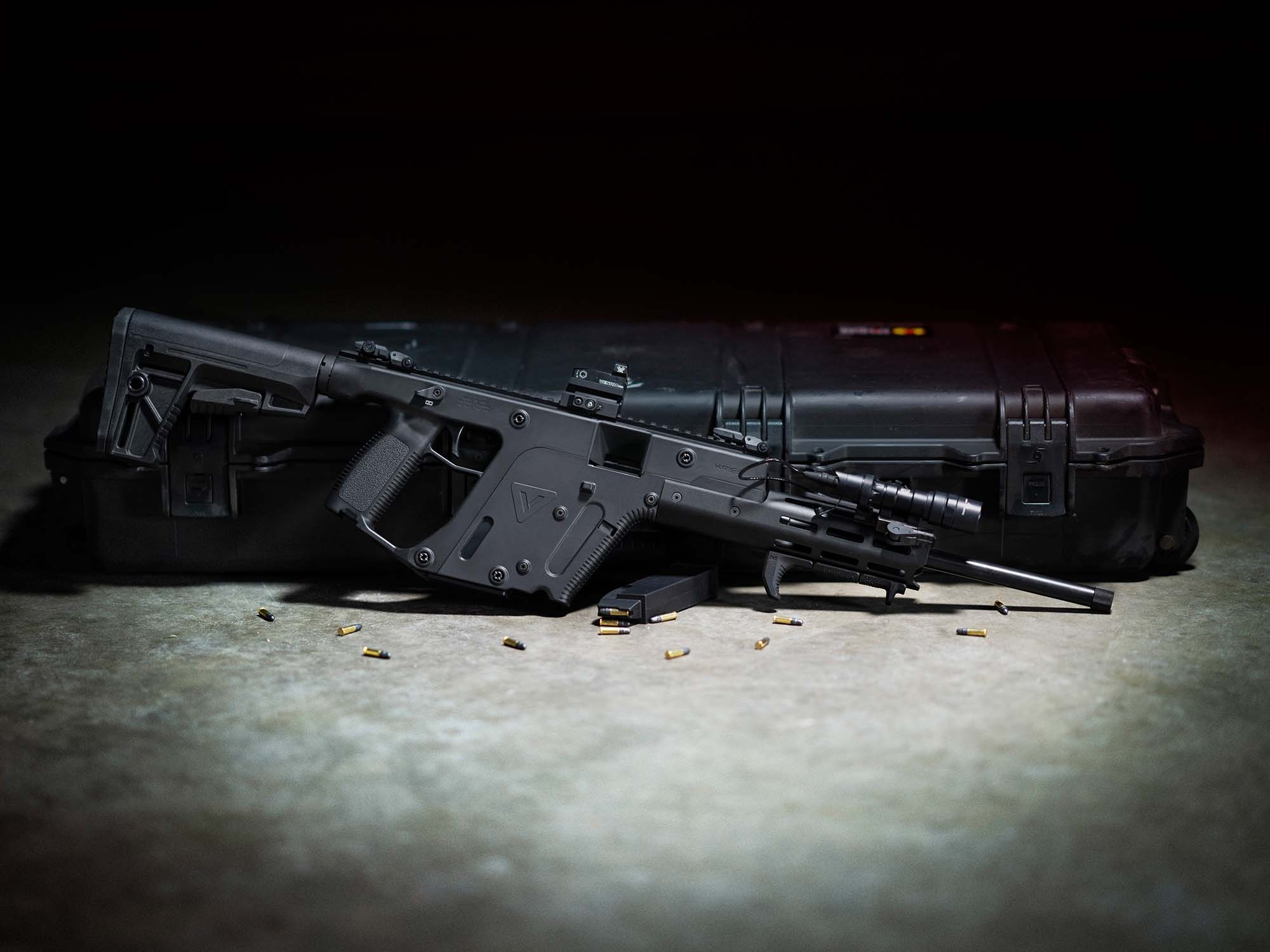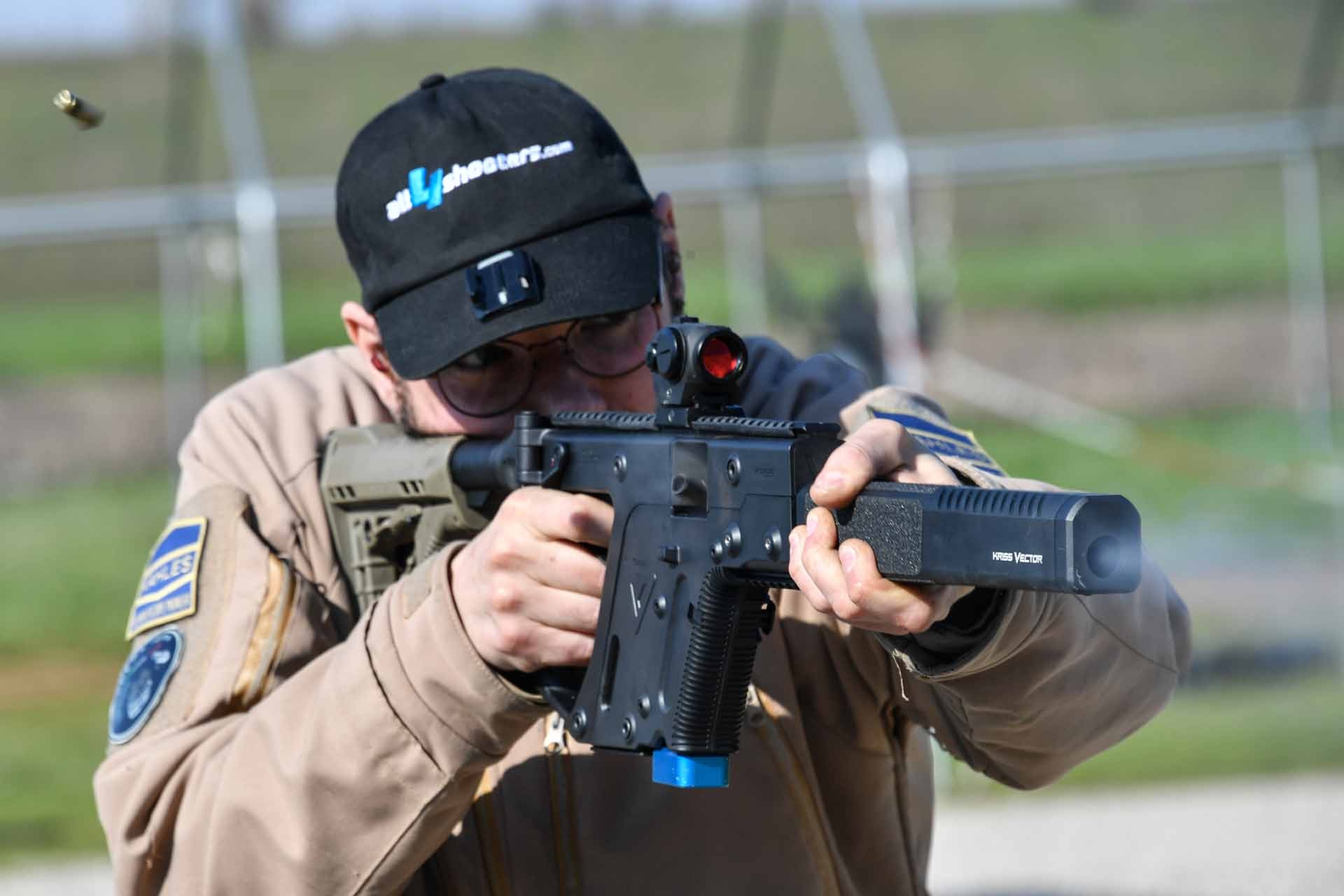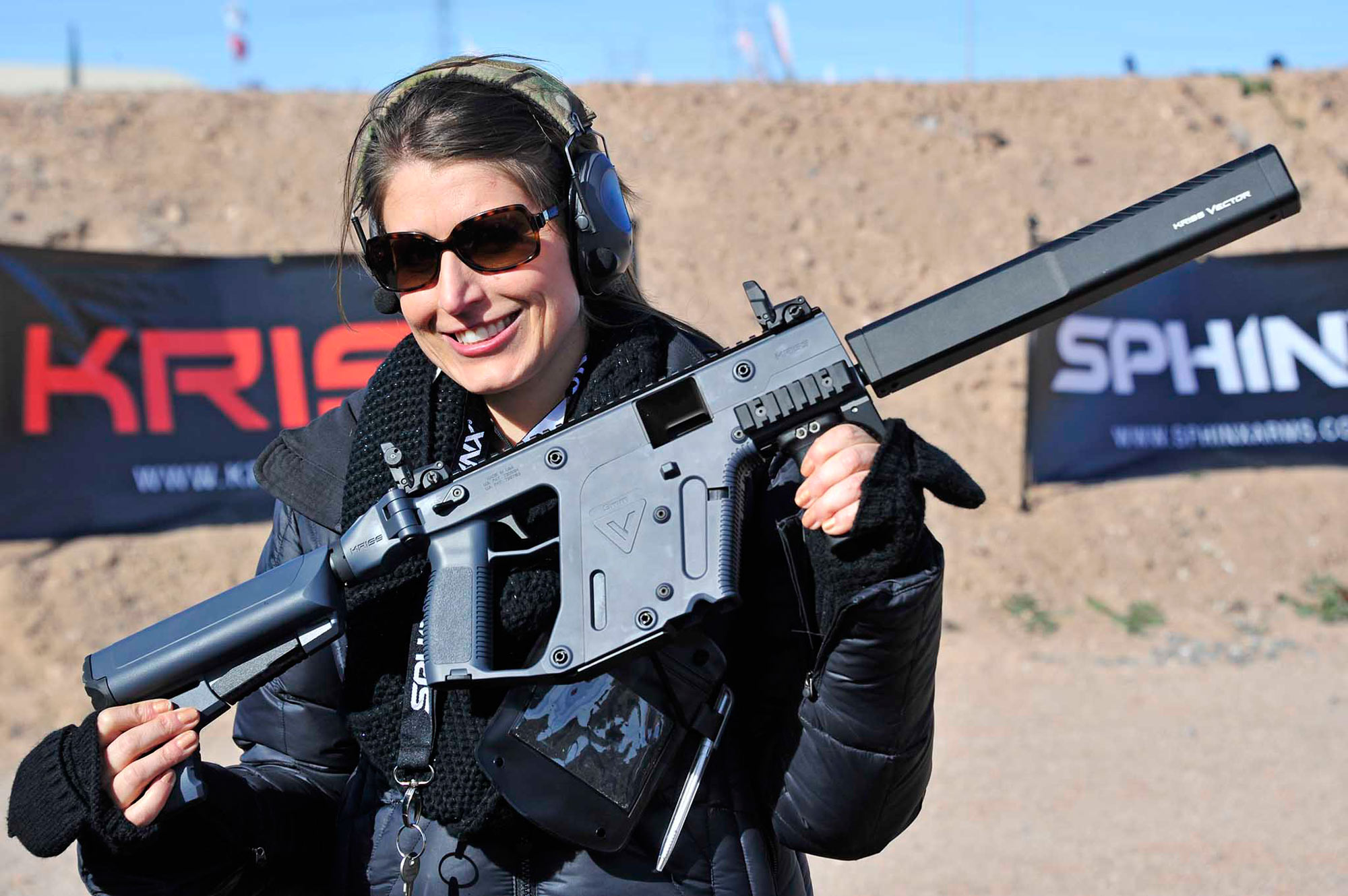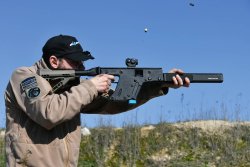
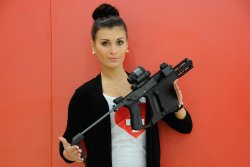
2007.
The development history the semi-automatic KRISS Vector firearms with the special "Super V" delayed blowback system goes back some years. To be precise, it goes back to 2005, when functional models of the KRISS Vector submachine gun in .45 Auto, manufactured by TDI in cooperation with Remington, appeared in the USA – but visually they had almost nothing in common with a gun.
In 2008, following the sampling of previously shown, further developed prototypes, we were able for the first time to see the production-ready "KRISS Super V XSMG" submachine gun and the civilian "KRISS Vector CRB/SO" semi-automatic carbine in .45 Auto from the US company Transformational Defense Industries, Inc. (TDI) at the 30th SHOT Show anniversary event in Las Vegas, Nevada. Since then, we have had the opportunity to test fire the futuristic-looking submachine gun in Germany, Switzerland or on the other side of the pond. In 2015, the second-generation models, improved in detail, were introduced.
The KRISS guns manufacturer: changing company history
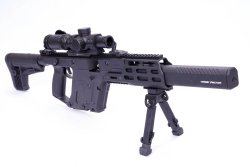
However, the original manufacturer in the form of KRISS Arms Group from Switzerland, which also offered the Sphinx pistols and Defiance suppressors, went bankrupt just a year later due to financial difficulties, leaving the TDI successor and one-time North American partner KRISS USA from Chesapeake, Virginia, as the sole manufacturer today. The company's current product line includes the Vector G2 submachine gun in 9x19 and .45 ACP (also available in blue FX and red training versions) for law enforcement and the military, and the Vector G2 semi-automatic carbine in five different build/barrel lengths in 9x19, 9x21, .40 S&W, 10mm Auto and .45 ACP calibers.
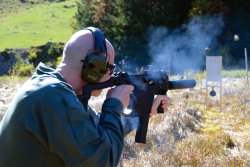
The CRB (CarBine Barrel) version we are talking about here features an M4 stock and 16"/406 mm barrel. A GLOCK magazine extension called the "MagEx2 Kit" is also offered, which replaces the original magazine base plate extending the magazine overall capacity to 40 rounds of 9mm, 33 rounds of 10mm, and 30 rounds of .45ACP.
That makes sense, since a Vector G2 submachine gun has a rate of fire of 800 rounds per minute. Incidentally, the rate of fire is adjustable at the customer's request and can be as high as 1100 rounds per minute.
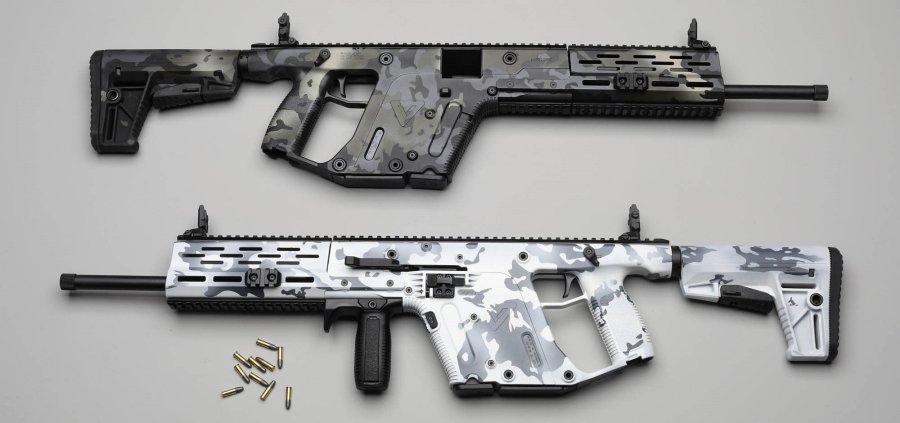
KRISS Vector submachine guns: who invented it?
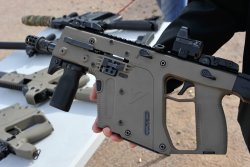
The patented design of this unusual weapon system came from a Frenchman named Renaud Kerbrat, who came from Brittany and lived in Switzerland, and who broke completely new ground. After all, the fundamental concept of a shoulder weapon had not changed much since the bolt-action rifle of the 19th century, even in the case of semiautomatic and fully automatic self-loaders.
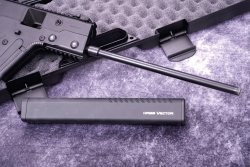
The bolt and barrel are positioned one behind the other in linear alignment with the barrel bore axis. The bolt, driven by recoil or gas pressure, moves linearly rearward against the recoil spring until the spent cartridge case is extracted from the chamber and the next cartridge is fed from the magazine. This linear design results in recoil running straight into the shoulder and muzzle flip. This physical phenomenon can be countered technically by positioning the bolt mass further forward around the barrel, as in the UZI-MP, making the shoulder stock emphatically straight, as in Stoner's M16/AR-15, and installing compensators at the muzzle.
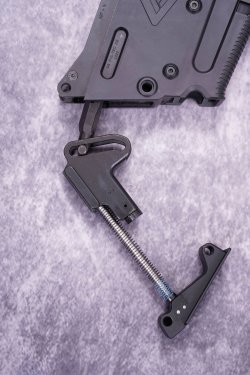
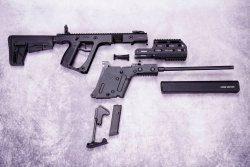
the low-bore axis.
But Renaud Kerbrat courageously left well-trodden paths by putting the linear principle to rest. After an extremely short, straight recoil, his delayed-blowback bolt does not simply continue to the rear in the conventional manner, but instead starts a downward travel. For this the gun features a center section into which the bolt dives. Especially with the SMG in .45 ACP, this makes for a completely unusual shooting sensation, even in full-auto fire, which reminds one of a .22 Long Rifle.
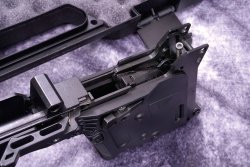
The bolt is connected at its rear end into a cam, which in turn connects it to a block with a V-shaped notch in it. At the moment of recoil, the bolt briefly moves backward and then forces the "Super V" bolt block downward against the recoil spring. This downward movement swallows much of the energy that would otherwise act in a straight line back into the shooter's shoulder. Because of the two angles in the cam, the bolt/block moves downward more slowly for the first few millimeters and then more rapidly at an acute angle, making it strictly speaking a delayed blowback system.
The block is fitted with a polymer buffer that dampens the impact of the block in the housing. In terms of timing, the system is designed so that exactly at the upstroke phase of recoiling, the block weight counteracts and pushes the gun down. This is the secret of the incredibly smooth shooting feel. With the semi-automatic carbine, you don't quite get the full enjoyment, yet you certainly feel a shorter-traveling impulse with reduced muzzle flip.
KRISS Vector G2 CRB: the carbine in detail
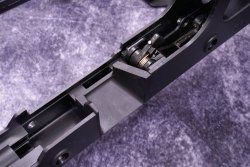
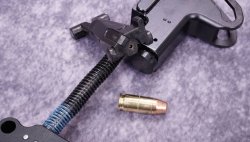
The main assemblies of the pistol caliber carbine are made of light alloy and are connected to each other with four HK G3-style push pins. The low-axis 16"/406mm barrel with 1-10" twist in 9x19 and 1-16" in .45 ACP is encased by a bolted-on aluminum shroud. The guns can be disassembled without tools so that the bolt assembly can be easily slid out of the center section from the bottom. Reassembly is also very simple and the assemblies are designed in such a way that you can't really make any user errors.
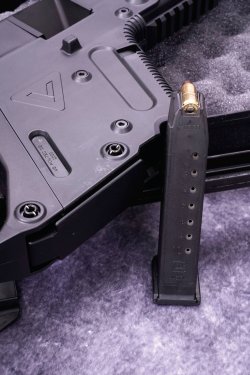
Our 9x19 version was fitted with an additional handguard attachment that proved helpful in practice because it both extends the sight radius when using iron sights and allows you to attach a bipod farther forward toward the muzzle, providing a more stable aiming. The light alloy "MK1 Vector Modular Rail" (VMR) handguard extension is attached to the receiver with four screws. Folding emergency sights ("Back Up Iron Sights", BUIS) are included. The magazine well is located in front in the center section and is fed with single-stack GLOCK magazines with a capacity of ten rounds. The M4 stock is the usual six-position style.
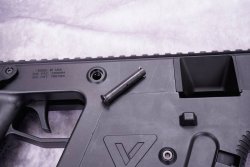
The single stage trigger with the technical feature of the overhead trigger-hammer linkage revealed quite usable characteristics with trigger weights in the 2700 g range on all four test guns, despite the large distance between the two components. This is a trigger pull weight that is also often found on typical factory AR rifles. In addition, the trigger weights of the quartet were all in almost the same range, so that the maximum difference in the average values of the trigger pull weights was a maximum of 240 grams. This testifies to the quality level of the manufacturer. The trigger on the KRISS Vector carbines is combined with a conveniently operable safety on both sides above the grip. The KRISS Vector G2 CRB models cost 2166 euros in .45 ACP caliber and 2138 euros in 9mm Luger caliber. Depending on the finish and any extra equipment – and the country you live in – prices may be different of course.
The KRISS Vector G22 CRB pistol carbine in .22LR in detail
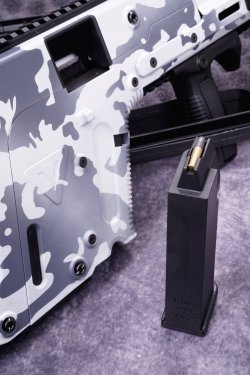
The rimfire versions are fitted with a conventional blowback bolt assembly inside, but with an identical outer design. Due to the shorter recoil travel and the hardly existing recoil impulse of the .22 Long Rifle, the complex "Super V" system would definitely have been superfluous here. In addition, the .22s do not have the barrel shrouds of the centerfire carbines. The 16"/405mm long barrels have a 1-16" twist and feature a 1/2x28 UNEF muzzle thread. Disassembly/assembly for maintenance and cleaning also work here with the HK G3 style push pins without tools. The .22 bolt is also equipped with a plastic buffer.
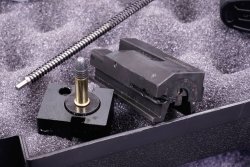
Upon meticulous inspection in the workshop, we can attest to KRISS carbines' overall high, appealing level of workmanship, both inside and out. The .22LR KRISS Vector G22 CRB price starts at 915 euro for a plain black finish.
The models shown here with "Multi-Coat Cerakote Camouflage Black" and "Multi-Coat Cerakote Camouflage Alpine" finishes cost 1272 euros.
The KRISS Vector pistol caliber carbines on the shooting range
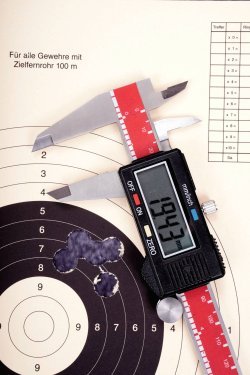
It certainly took a lot of time, energy and money to adjust the timing of the special delayed-blowback action of the SMG and carbines in the centerfire calibers so that this incomparable shooting sensation could be achieved. But in the end, the effort was worth it, because the KRISS Vector G2 CRB models in .45 ACP and 9 mm Luger worked absolutely perfectly. The KRISS Vector G22 CRB model in .22LR with its simple blowback action was in no way inferior. Since our two rimfire versions differed only in finish, we test fired just one model.
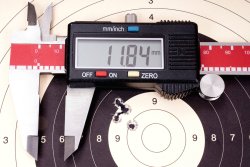
For accuracy testing at 50 meters, we equipped the KRISS Vector carbine with a Falke 1-8x26 scope and an UTG bipod. Pre-adjustment of the optics by classic barrel alignment is not possible with the KRISS semi-autos due to their design. Therefore, it is recommended that the rifles first be fired at a shorter distance or that an adjustment laser be used, as we did. We tested the KRISS Vector G22 CRB with eight .22LR ammunition types. We tried the 9mm KRISS Vector G2 CRB carbine with ten factory ammunition loads, with bullet weights ranging from 95 to 158 grains. With the .45 model, we were able to achieve best groupings of 19 millimeters (200 grains WM Bullets SWC) when using nine factory cartridges with bullet weights ranging from 185 to 230 grains. It is not without a certain irony that we were able to achieve the best group with the futuristic .45 carbine using, of all things, the German "Cowboy Action" cartridge.
KRISS Vector G2 CRB and KRISS Vector G22 CRB specs and prices
| Model: | KRISS Vector G22 CRB .22LR | KRISS Vector G2 CRB 9mm Luger | KRISS Vector G2 CRB .45 ACP |
| Action: | Blowback | Delayed blowback | Delayed blowback |
| Barrel: | 15.94”/405
mm long barrel with 1-16" twist, 17 mm outer diameter and 1/2x28 UNEF muzzle
thread with cover plate | 15.98”/406 mm long barrel with 1-10" twist | 15.98”/406 mm long barrel with 1-16" twist |
| Stock: | Length
adjustable 6-position M4, handguard with Picatinny rails | Length adjustable 6-position M4, handguard with Picatinny rails | Length adjustable 6-position M4, handguard with Picatinny rails |
| Magazine: | Polymer
10-round box magazine | Polymer GLOCK 10-round box magazine | Polymer GLOCK 10-round box magazine |
| Trigger: | Single-stage
trigger, measured trigger pull weight: 2670-2750 g | Single-stage trigger, measured trigger pull weight: 2730 g | Single-stage trigger, measured trigger pull weight: 2510 grams |
| Safety: | Two-position
safety above the grip, acting directly on the trigger | Two-position
safety above the grip, acting directly on the trigger | Two-position
safety above the grip that acts directly on the trigger |
| Overall
Length: | 88-96
cm | 88.5
-96.5 cm | 88.5 cm
-96.5 cm |
| Weight: | 7.7
lb/3.5 kg | 8.8
lb/4.0 kg | 8.3
lb/3.8 kg |
| Prices: | From 915
euro (camo version shown here: 1272 euro) | 2138 euro | 2166 euro |
KRISS Vector pistol caliber carbines: wrapping up
The KRISS Vector PCCs impress with their clean workmanship, function and shooting performance. Sure, they are not the first choice for purebred precision disciplines, but they can certainly be used in dynamic shooting sports disciplines.
It is guaranteed that curiosity will be aroused when a KRISS Vector carbine is freed from its carrying case and bag at a shooting range full of fellow shooters. The prices starting at 915 euros for the rimfire rifles and 2138 euros for the 9x19 rifles are perfectly acceptable, not least because of the unusual design and action system.
Text: Stefan Perey/Michael Fischer
Further information on the futuristic KRISS Vector pistol caliber carbines can be found on the KRISS website.



